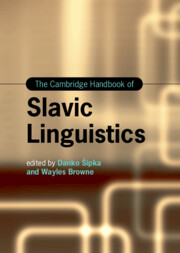Book contents
- The Cambridge Handbook of Slavic Linguistics
- Cambridge Handbooks in Language and Linguistics
- The Cambridge Handbook of Slavic Linguistics
- Copyright page
- Contents
- Figures
- Tables
- Contributors
- Introduction
- Part 1 Prosody and Phonology
- Part 2 Inflectional and Derivational Morphology
- 7 Inflectional Endings: Declensions
- 8 Inflectional Endings: Conjugation
- 9 Tense and Mood Forms
- 10 Aspect in Verbs
- 11 Lexical Derivation
- 12 Lexical Composition
- Part 3 Syntax
- Part 4 Lexicon
- Part 5 Sociolinguistic and Geographical Approaches
- Part 6 Experimental and Quantitative Approaches
- Name Index
- Subject Index
- References
7 - Inflectional Endings: Declensions
from Part 2 - Inflectional and Derivational Morphology
Published online by Cambridge University Press: 16 May 2024
- The Cambridge Handbook of Slavic Linguistics
- Cambridge Handbooks in Language and Linguistics
- The Cambridge Handbook of Slavic Linguistics
- Copyright page
- Contents
- Figures
- Tables
- Contributors
- Introduction
- Part 1 Prosody and Phonology
- Part 2 Inflectional and Derivational Morphology
- 7 Inflectional Endings: Declensions
- 8 Inflectional Endings: Conjugation
- 9 Tense and Mood Forms
- 10 Aspect in Verbs
- 11 Lexical Derivation
- 12 Lexical Composition
- Part 3 Syntax
- Part 4 Lexicon
- Part 5 Sociolinguistic and Geographical Approaches
- Part 6 Experimental and Quantitative Approaches
- Name Index
- Subject Index
- References
Summary
The chapter opens with a basic structural description of declensional patterns in Slavic languages, concentrating on several pervasive, salient, and typologically important features. The Late Common Slavic (LCS) system is outlined, with samples of key substantival and pronominal paradigms. Next, the survey traces crucial changes from LCS into the modern languages in the organization of nominal inflection into classes, including emergence of patterns specific for adjectives and numerals. Also discussed is the prehistory of the LCS system and its contextualization within the Indo-European family. Finally, the chapter reviews a number of mostly post-LCS innovations involving interesting synchronic or diachronic problems, such as: encoding virility and animacy; encoding innovative case/number categories (‘second locative’, partitive, paucal, etc.); patterns of syncretism and developments towards analyticity; defectivity and indeclinability; recycling of former dual endings; rise of definiteness markers; transfers to and from declensional morphology; role of segmental alternations and prosodic distinctions in declensional systems.
- Type
- Chapter
- Information
- The Cambridge Handbook of Slavic Linguistics , pp. 129 - 160Publisher: Cambridge University PressPrint publication year: 2024



